#rhino embryo transfer
Text
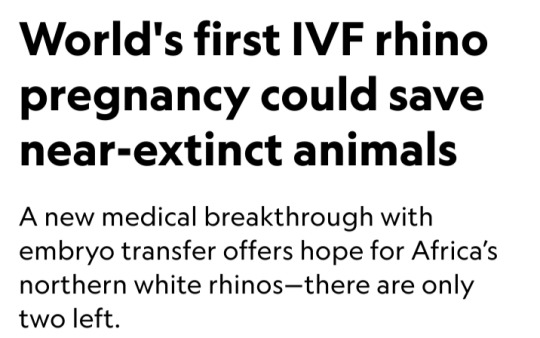

By Dina Fine Maron
January 24, 2024
Scientists have cleared a significant hurdle in the years-long effort to save Africa’s northern white rhinoceros from extinction with the first-ever rhino pregnancy using in vitro fertilization.
The lab-assisted pregnancy, which researchers will announce today, involved implanting a southern white rhino embryo in a surrogate mother named Curra.
The advance provides the essential “proof of concept” that this strategy could help other rhinos, says Jan Stejskal of the BioRescue project, the international group of scientists leading this research.
Curra died just a couple months into her 16-month pregnancy from an unrelated bacterial infection, Stejskal says.
However, the successful embryo transfer and early stages of pregnancy pave the way for next applying the technique to the critically endangered northern white rhino.
The process was documented exclusively by National Geographic for an upcoming Explorer special currently slated to air in 2025 on Nat Geo and Disney+.
BioRescue expects to soon implant a northern white rhino embryo into a southern white rhino surrogate mother.
The two subspecies are similar enough, according to the researchers, that the embryo will be likely to develop.
Eventually, this approach may also help other critically endangered rhinos, including the Asian Javan rhinoceros and the Sumatran rhinoceros, which each now number under 100 individuals, Stejskal says.
But the northern white rhino’s current situation is the most pressing by far.
There are no males left, and the only two remaining animals are both elderly females that live under armed guard on a reserve in a 700-acre enclosure in Kenya called Ol Pejeta Conservancy.
The boxy-jawed animals once roamed across central Africa, but in recent decades, their numbers have plummeted due to the overwhelming international demand for their horn, a substance used for unproved medicinal applications and carvings.
Made from the same substance as fingernails, rhino horn is in demand from all species, yet the northern white rhino has been particularly hard-hit.
"These rhinos look prehistoric, and they had survived for millions of years, but they couldn’t survive us,” says Ami Vitale, a National Geographic Explorer and photographer who has been documenting scientists’ efforts to help the animals since 2009.
“If there is some hope of recovery within the northern white rhino gene pool — even though it’s a substantially smaller sample of what there was — we haven’t lost them,” says conservation ecologist David Balfour, who chairs the International Union for the Conservation of Nature’s African rhino specialist group.
Blueprints for rhino babies
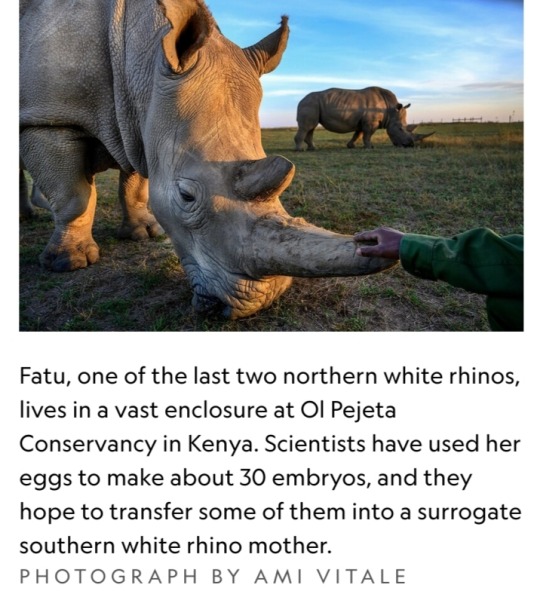
To stave off the animal’s disappearance, BioRescue has used preserved sperm from northern white rhinos and eggs removed from the younger of the two remaining females.
So far, they’ve created about 30 preserved embryos, says Thomas Hildebrandt, the head scientist of BioRescue and an expert in wildlife reproduction based at the Leibniz-Institute of Zoo and Wildlife Research in Berlin.
Eventually, the team plans to reintroduce northern white rhinos into the wild within their range countries.
“That’d be fantastic, but really, really far from now—decades from now,” says Stejskal.
Worldwide, there are five species of rhinoceros, and many are in trouble.
Across all of Africa, there are now only about 23,000 of the animals, and almost 17,000 of them are southern whites.
Then there are more than 6,000 black rhinos, which are slightly smaller animals whose three subspecies are critically endangered.
In Asia, beyond the critically endangered Javan and Sumatran rhinos, there’s also the greater one-horned rhino, whose numbers are increasing and currently are estimated to be around 2,000.
The BioRescue effort has experienced many setbacks, and even though the team now has frozen embryos, the clock is ticking.
The researchers intend to use southern white rhinos as surrogate moms for the northern white rhino embryos.
However, scientists want any northern white rhino calves to meet and learn from others of their kind, which means they need to be born before the two remaining females die.
“These animals learn behaviors — they don’t have them genetically hard-wired,” says Balfour, who’s not involved with the BioRescue work.
But birthing new animals in time will be a challenge.
“We’re really skating on the edge of what’s possible,” he says, “but it’s worth trying.”
Najin, the older female, will be 35 this year, and Fatu will be 24.
The animals, which were born in a zoo in the Czech Republic, are expected to live to about 40, says Stejskal, who also serves as director of international projects at the Safari Park Dvůr Králové, the zoo where the animals lived until they were brought to Kenya in 2009.
Impregnating a rhino
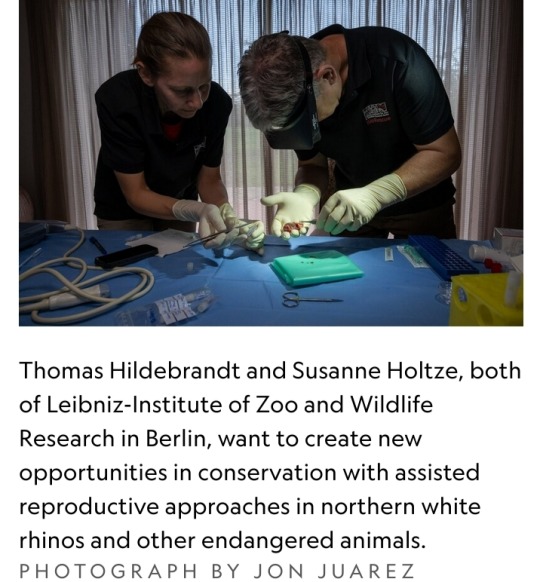
The next phase of BioRescue’s plan involves implanting one of their limited number of northern white rhino embryos into a southern white rhino surrogate mother — which the group plans to do within the next six months, Stejskal says.
They’ve identified the next surrogate mother and set up precautions to protect her from bacterial infections, including a new enclosure and protocols about disinfecting workers’ boots.
But now, they must wait until the female rhino is in estrus — the period when the animal is ready to mate — to implant the egg.
To identify that prime fertile time, they can’t readily perform regular ultrasounds at the conservancy as they might do in a zoo.
Instead, they have enlisted a rhino bull that has been sterilized to act as a “teaser” for the female, Hildebrandt says, adding that they must wait a few months to make sure that their recently sterilized male is truly free of residual sperm.
Once the animals are brought together, their couplings will alert conservancy staff that the timing is right for reproductive success.
The sex act is also important because it sets off an essential chain of events in the female’s body that boosts the chances of success when they surgically implant the embryo about a week later.
"There’s little chance the conservancy staff will miss the act. White rhinos typically mate for 90 minutes," Hildebrandt says.
What’s more, while mounted on the females, the males often use their temporary height to reach tasty plant snacks that are generally out of reach.
Boosting genetic diversity
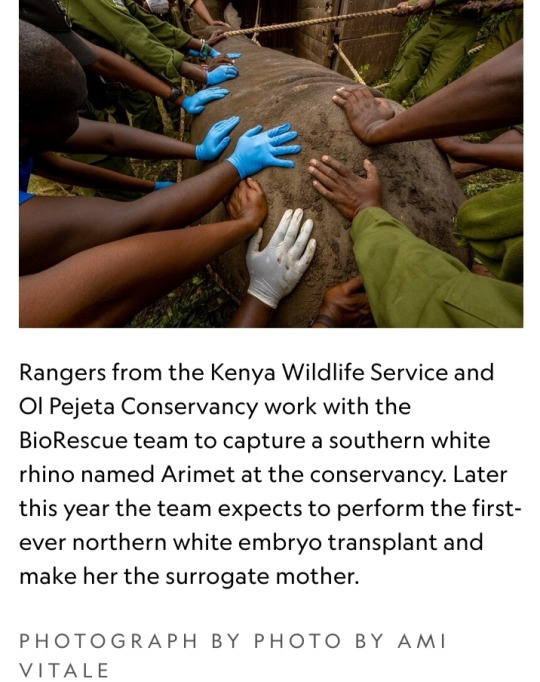
With so few northern white rhinos left, their genetic viability may seem uncertain.
But the BioRescue team points to southern white rhinos, whose numbers likely dropped to less than 100, and perhaps even as few as 20, due to hunting in the late 1800s.
Government protections and intense conservation strategies allowed them to bounce back, and now there are almost 17,000.
“They have sufficient diversity to cope with a wide range of conditions,” says Balfour.
Researchers don’t know exactly how many southern white rhinos existed a century ago, he says, but it’s clear that the animals came back from an incredibly low population count and that they now appear healthy.
Beyond their small collection of embryos, the BioRescue team hopes to expand the northern white rhino’s gene pool by drawing from an unconventional source — skin cells extracted from preserved tissue samples that are currently stored at zoos.
They aim to use stem cell techniques to reengineer those cells and develop them into sex cells, building off similar work in lab mice.
According to their plan, those lab-engineered sex cells would then be combined with natural sperm and eggs to make embryos, and from there, the embryos would be implanted into southern white rhino surrogate mothers.
Such stem cell reprogramming work has previously led to healthy offspring in lab mice, Hildebrandt says, but rhinos aren’t as well-studied and understood as mice, making this work significantly challenging.
A global effort
The northern white rhino revitalization venture has cost millions of dollars, supported by a range of public and private donors, including the German Federal Ministry of Education and Research.
Other partners on the effort include the Leibniz Institute for Zoo and Wildlife Research, the Czech Republic’s Safari Park, Kenya Wildlife Service, Ol Pejeta Conservancy, and also Katsuhiko Hayashi, a professor of genome biology at Osaka University in Japan who conducted the mouse stem cell research.
Building upon Hayashi’s stem cell techniques could ultimately bring the northern white rhino gene pool up to 12 animals — including eggs from eight females and the semen of four bulls, according to Stejskal.
An alternative approach to making more babies, like crossbreeding northern and southern white rhinos, would mean the resulting calves wouldn’t be genetically pure northern white rhinos, Hildebrandt notes.
The two subspecies look quite similar, but the northern version has subtle physical differences, including hairier ears and feet that are better suited to its swampy habitat.
The two animals also have different genes that may provide disease resiliency or other benefits, Hildebrandt says.
There are unknown potential differences in behavior and ecological impact when populating the area with southern white rhinos or cross-bred animals.
"The northern white rhino is on the brink of extinction really only due to human greed,” Stejskal says.
“We are in a situation where saving them is at our fingertips, so I think we have a responsibility to try.”
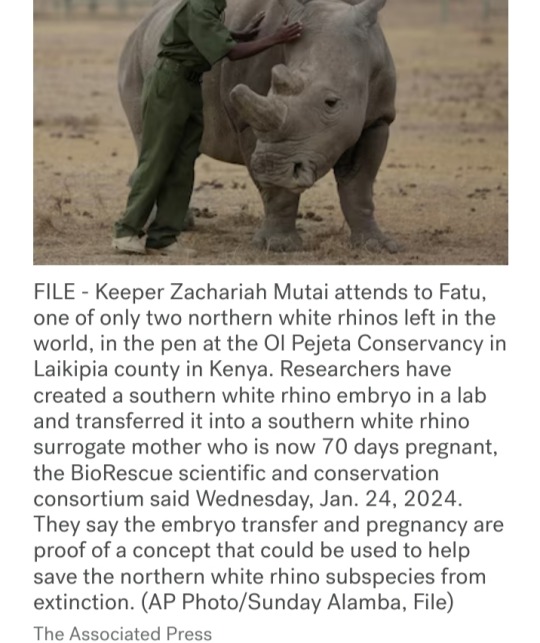
🩶🦏🩶
#northern white rhinoceros#rhino embryo transfer#in vitro fertilization#IVF#southern white rhinoceros#critically endangered animals#National Geographic#BioRescue#rhino horn#International Union for the Conservation of Nature#African rhino specialist group#Thomas Hildebrandt#German Federal Ministry of Education and Research#Leibniz Institute for Zoo and Wildlife Research#Kenya Wildlife Service#Ol Pejeta Conservancy#Katsuhiko Hayashi#genome biology#IVF rhino pregnancy
8 notes
·
View notes
Text
The Kenya Wildlife Service celebrated the successful transfer of 21 eastern black rhinos to establish a new viable breeding population for the species that was on the brink of extinction decades ago.
In an 18-day exercise executed by highly trained capture and veterinary experts, the Loisaba Conservancy received the 21 rhinos from three different locations, becoming the 17th sanctuary in Kenya where the mammoth animals can roam and intermingle.
“It’s incredibly exciting to be part of the resettlement of rhinos to a landscape where they’ve been absent for 50 years,” said Tom Silvester, CEO of Loisaba Conservancy.
Kenya had 20,000 black rhinos in the 1970s before poachers decimated them for their horns. By the time the Kenya Wildlife Service (KWS) was established in 1989, rhino numbers had declined to below 400.
Since then, Kenya’s eastern black rhinos have made a remarkable comeback and today there are an estimated 1,004 individuals.
Kenya is a stronghold of the eastern sub species of black rhino, hosting approximately 80 percent of the entire world’s surviving population.
“Surpassing the milestone of 1,000 rhinos within four decades is a significant accomplishment,” said Munira Bashir, Director of The Nature Conservancy in Kenya.
The reintroduction this month of these 21 animals this month is a great milestone in Kenya’s rhino recovery action plan, and was made possible by support from The Nature Conservancy, San Diego Zoo Wildlife Alliance, other partners—and the three reserves from where the 21 rhinos originated, Nairobi National Park, Ol Pejeta Conservancy and Lewa Conservancy.
“In the recent past, one of the main causes of mortality of rhinos has been territorial fights due to limited space in sanctuaries which has also led to suppressed growth rates due,” explained Dr. Erustus Kanga, the Director General of Kenya Wildlife Service. “I am elated to be associated with this momentous effort to secure more space for this cornerstone species.”
Meanwhile, southern white rhinos continue to thrive in Kenya, having increased from 50 individuals that were imported from South Africa in the eighties and nineties to reach the current population of 971 individuals.
Kenya is also playing a critical role in efforts to save the northern white rhino from extinction, as it is host to the only remaining two females of the species left in the world. The international BioRescue project has developed thirty embryos awaiting implantation into surrogate females within the closely-related subspecies of southern white rhino.
“The return of black rhinos to Loisaba, 50 years after the last known individual here was killed by poachers in the 1970s, is a demonstration of how impactful partnerships between governments and conservation NGOs can be for restoring, managing, and protecting our natural world,” said Dr. Max Graham, CEO and Founder of Space for Giants, one of the project partners.
“And, of course, the return of black rhinos here gives all of us one of the most precious commodities of all: hope.”
-via Good News Network, February 25, 2024
#rhino#rhinoceros#conservation#hope posting#endangered species#wildlife#kenya#good news#hope#zoology#zoo animals#keystone species
341 notes
·
View notes
Photo

Photo by @amivitale. One of the last northern white rhinos on the planet leaves Dvůr Králové Zoo (@safariparkdvurkralove) in Czechia in December 2009 for Ol Pejeta Conservancy in Kenya. The move was prompted by the fact that northern white rhinos had been declared extinct in the wild in 2009. It was thought that the air, water, and food, not to mention room to roam in Kenya, might stimulate the rhinos to breed and thereby ensure the continued existence of their subspecies. Local Czechs protested the relocation; they didn’t want to lose the rhinos and felt the move was too risky. Fatu and her mother Najin are the only northern white rhinos alive today but remarkably, all hope is not lost. Thanks to an international consortium of scientists known as the @BioRescue_Project, there are now 24 northern white rhino embryos that are ready to be transferred into surrogate southern white rhino females in the near future. This will have profound implications for other species of rhino that are also critically endangered—as well as the more than 42,000 animals threatened with extinction on Earth today. I have just launched the new short film “Remembering Sudan,” documenting the heartbreaking crisis facing northern white rhinos, the incredible efforts to save them, and the work of keepers like Zacharia Mutai of @OlPejeta Conservancy, who sacrifice so much to protect them. I hope that you will take time to watch it and support the important conservation work of Ol Pejeta Conservancy. All ticket sales go to supporting @OlPejeta, which cares for Najin and Fatu, the last two northern white rhinos on the planet. Visit rememberingsudan.org or click on the link in my profile to watch today. Thank you to @zacharia_mutai @olpejeta @biorescue_project @mediastorm and @danehenrydigital for your beautiful collaboration. #rememberingsudan #northernwhiterhinos #amivitale #dontletthemdisappear #documentaryphotography https://www.instagram.com/p/CqDu5SIsy86/?igshid=NGJjMDIxMWI=
3 notes
·
View notes
Text
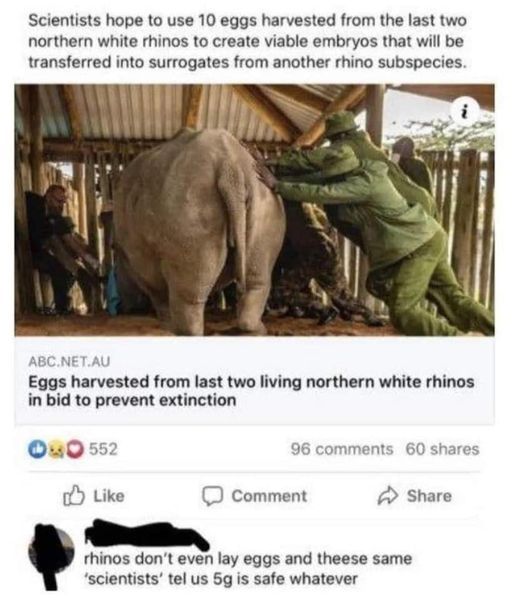
World's first successful embryo transfer in rhinos paves the way for saving the northern white rhinos from extinction
0 notes
Text
0 notes
Link
[ad_1] The fertilized eggs are ready for transfer to wild southern white rhino surrogate mothers, the BioRescue research consortium says A team of scientists working in Kenya announced on Monday that five new embryos have been created to save Africa’s northern white rhino from extinction.BioRescue, the research consortium in charge of the project, said 18 eggs were collected from a female named Fatu in May and fertilized with sperm from two different bulls to improve “genetic diversity.”Fatu and her mother, Najin, are the world’s two remaining northern white rhinos and live on Kenya’s 90,000-acre Ol Pejeta wildlife conservancy, which is under poacher protection.The northern white rhino subspecies was declared functionally extinct in 2018 following the death of the last male, Sudan.“Four years since the start of this ambitious project to save the Northern White Rhino from extinction, the BioRescue consortium has made significant progress towards its ultimate aim,” BioRescue said in a statement.The latest effort by the consortium has yielded the highest number of embryos from any egg collection since the onset of the project.“Previous procedures in November 2022 and February 2023 yielded two and zero embryos, respectively,” it stated.So far, 29 fertilized eggs have been created using advanced assisted reproduction technologies and have been cryopreserved, a process that keeps them at low temperatures for future transfer to surrogate mothers.The consortium said its scientists have identified two wild southern white rhino females as potential surrogate mothers, as both Fatu and Najin are unable to carry a pregnancy to full term. The project is a collaborative effort, with scientists from the Leibniz Institute in Berlin assisting the Kenya Wildlife Service and Ol Pejeta, and the Italian Avantea Laboratory providing fertilization support. It is mainly funded by the German Federal Ministry of Education and Research.Kenya’s Ol Pejeta Conservancy called the development “fantastic news” and commended the team for its “phenomenal dedication and hard work that have made this all possible.” You can share this story on social media: Follow RT on [ad_2]
0 notes
Photo
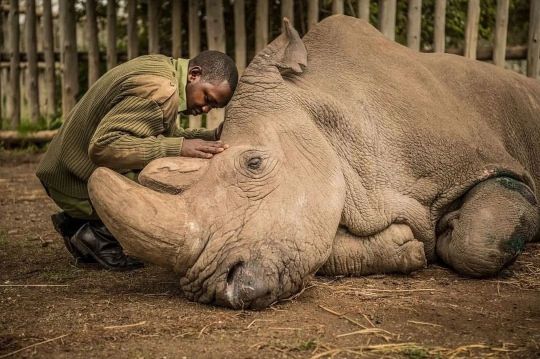
Reposted from @rhoveafrica Back to the story of Sudan, the last living northern white rhino male passed away 4 years ago. #Repost Photos by @amivitale | Four years ago, Sudan, the last living northern white rhino male passed away. At 45, Sudan was old for his species. He'd lived a long life and found stardom as the “most eligible bachelor in the world.” In his final moments, there was only silence, except for drops of rain and the muffled tears of the people who loved and protected him. I think back often on this moment and it's the silence I remember most—a haunting silence that seemed to foreshadow what a world without wildlife would be like. Without these creatures, we suffer more than the loss of an ecosystem. We suffer a loss of imagination, a loss of wonder, a loss of possibilities. Figuring out how to create a sustainable and just human society that doesn’t destroy the natural world is our single most important challenge. Hope always remains. What’s going to save us all is to get beyond our routine ways of thinking; wonder is what allows us to reimagine our future together. Wonder allows us to believe that we can fundamentally change the course we are currently on. Thanks to the groundbreaking and inspiring work of the @biorescue_project, northern white rhino embryos will be transferred into a surrogate southern white rhino mother in the near future. The species may still be saved from extinction. Learn more, including how you can help, by following @BioRescue_project @olpejeta, @SafariParkDvurKralove and @amivitale #kenya #rhinos #rhoveafrica https://www.instagram.com/p/CfOSy8uqnWc/?igshid=NGJjMDIxMWI=
0 notes
Link
Excerpt from this EcoWatch story:
Seven eggs from the world's last northern white rhinoceroces have been successfully fertilized in a lab, scientists announced on Monday.
Ten eggs were extracted from two females, Najin and Fatu, last week in Kenya, but only seven of them were fit to be artificially inseminated.
"We expect some of them will develop into an embryo," Cesare Galli, a founder of the Italian assisted-breeding company Avantea.
The team used frozen sperm that had been harvested from two male northern white rhinos before they died.
"This is the next critical step in hopefully creating viable embryos that can be frozen and then later on transferred to southern white rhino surrogate mothers," the scientists said in a statement.
Veterinarians and wildlife experts are hoping to use a surrogate mother rhino, as Najin and Fatu are unable to carry a pregnancy.
This is Sudan, the last male northern white rhino, just before he died on March 19, 2018. From Time Magazine.

And here are Najin and Fatu. This photo was taken last Friday (August 23, 2019).
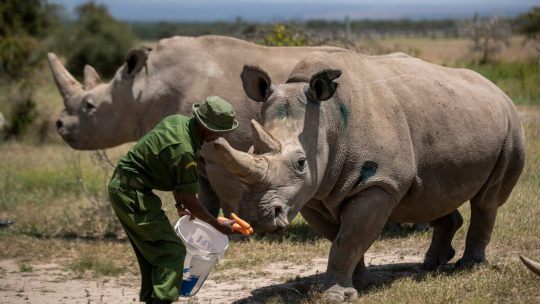
Female northern white rhinos Fatu, 19, right, and Najin, 30, left, the last two northern white rhinos on the planet, are fed some carrots by a ranger in their enclosure at Ol Pejeta Conservancy, Kenya Friday, Aug. 23, 2019. Wildlife experts and vets say there is hope for the northern white rhino which is on the verge of extinction, after they successfully managed to draw eggs Thursday from the last two of the species, hoping they can be used to reproduce the species through a surrogate. (AP Photo/Ben Curtis)
9 notes
·
View notes
Text
Scientists Harvest Eggs From World’s Last 2 Northern White Rhinos
Researchers hope to use the eggs to create viable embryos that can transferred into surrogates since neither animal can carry a pregnancy to term.
Scientists Harvest Eggs From World’s Last 2 Northern White Rhinos syndicated from https://triviaqaweb.blogspot.com/
0 notes
Photo

Photo by @amivitale. March 19, 2023, marks the fifth anniversary of the death of Sudan, the last known male northern white rhino on the planet. Here, JoJo Wachira gives his last goodbye to Sudan before he died at @OlPejeta Conservancy in northern Kenya. It was silent, except for the rain falling, a single bird scolding, and the muffled sorrow of Sudan’s caretakers. Watching a creature die—one that is the last of its kind—is something I hope never to experience again. It felt like watching our own demise. With Sudan’s death, the northern white rhino is functionally extinct, but remarkably, all hope is not lost. Thanks to an international consortium of scientists known as the @BioRescue_Project, there are now 24 northern white rhino embryos that are ready to be transferred into surrogate southern white rhino females in the near future. This will have profound implications for the other species of rhino that are also critically endangered—as well as the more than 42,000 animals threatened with extinction on Earth today, as well as the more than 16,000 endangered animals on Earth today. I have just launched the new short film “Remembering Sudan,” documenting the heartbreaking crisis facing the northern white rhinos, the incredible efforts to save them, and the work of keepers like Zacharia Mutai of Ol Pejeta Conservancy, who sacrifice so much to protect them. I hope that you will take time to watch it. All the proceeds will support the important conservation work of Ol Pejeta Conservancy, which cares for Najin and Fatu, the last two northern white rhinos. Visit rememberingsudan.org or click on the link in my profile to watch today. #rememberingsudan #northernwhiterhinos #amivitale #dontletthemdisappear #documentaryphotography https://www.instagram.com/p/Cp5nfNMPlYR/?igshid=NGJjMDIxMWI=
2 notes
·
View notes
Photo

Scientists successfully created two northern white rhino embryos — to be transferred to a surrogate mother in the near future. || 9gagrss || https://ift.tt/2WAthEm https://ift.tt/2PEKNWE ||
0 notes
Text
Scientists Create Two Northern White Rhino Embryos
Scientists have created two embryos of the nearly extinct northern white rhino, part of an effort to pull the species back from the brink.
"Today we achieved an important milestone on a rocky road which allows us to plan the future steps in the rescue program of the northern white rhino,'' said Thomas Hildebrandt of the Leibniz Institute for Zoo and Wildlife Research in Germany.
The institute is part of a team of international scientists and conservationists racing to save the rare giants.
The eggs were harvested from the last two living females. They were injected with the frozen sperm of dead males.
The embryos will be transferred into a surrogate mother, a southern white rhino.
The conservationists hope to create a herd of at least five animals that can be introduced back into the wild in Africa.
The last male northern white rhino, Sudan, died last year at age 45. He gained international fame in 2017 when he was named the "The Most Eligible Bachelor in the World'' on the Tinder dating app as part of fundraising effort.
"Five years ago, it seemed like the production of a northern white rhino embryo was almost an unachievable goal, and today we have them," said Jan Stejskal, director of communication at the Dvur Kralove Zoo in the Czech Republic, where the last two surviving females were born.
from Blogger https://ift.tt/32wtMRA
via IFTTT
0 notes
Text
Scientists a step closer to saving northern white rhino from extinction
https://sciencespies.com/biology/scientists-a-step-closer-to-saving-northern-white-rhino-from-extinction/
Scientists a step closer to saving northern white rhino from extinction
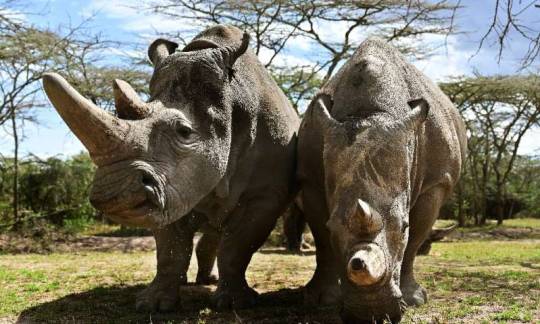

Najin and daughter Fatu are the only surviving northern white rhinos
More
Veterinarians have successfully harvested eggs from the last two surviving northern white rhinos, taking them one step closer to bringing the species back from the brink of extinction, scientists said in Kenya on Friday.
Science is the only hope for the northern white rhino after the death last year of the last male, named Sudan, at the Ol Pejeta Conservancy in Kenya where the groundbreaking procedure was carried out Thursday.
Two females, Najin, 30, and daughter Fatu, 19, are the only survivors of the subspecies of white rhino, and live under 24-hour armed guard at Ol Pejeta.
However neither is able to carry a calf. Fatu has degenerative lesions in her uterus and Najin has weak hind legs which could cause complications if she fell pregnant.
But an international consortium of scientists and conservationists has been working on a project costing several million euros to save the northern white rhino using pioneering artificial reproduction techniques that have taken years of research and development.
Technique developed from scratch
“We were able to harvest a total of 10 oocytes—five from Najin and five from Fatu—showing that both females can still provide eggs and thus help to save these magnificent creatures,” said Professor Thomas Hildebrandt from the Leibniz Institute for Zoo & Wildlife Research (IZW) in Germany who helped carry out the procedure.
“Both the technique and the equipment had to be developed entirely from scratch,” he said.
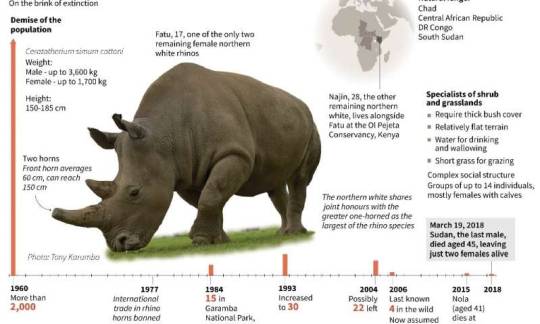
The northern white rhino is on the brink of extinction
More
The eggs—which cannot be frozen—were immediately flown to a laboratory in Italy to be fertilised with cryogenically frozen sperm, of which there are samples from four deceased males.
The resulting embryos will then be frozen until they can be transferred into a surrogate mother from the southern white rhino subspecies. The first such rhino embryos using in-vitro techniques were created last year.
The team working on the project also includes Italian biotech laboratory Avantea, Czech zoo Dvur Kralove and the Kenya Wildlife Service (KWS).
“We are delighted that this partnership gets us one step closer to prevent extinction of the northern white rhinos. This is particularly touching given the heartbreaking death of Sudan, the last male, who died of old age last year in Kenya,” said John Waweru, KWS director general.
Sudan gained worldwide fame in 2017 after he was featured on the popular dating app Tinder in an effort to raise money for the IVF procedure.
Wiped out by poaching
There are five rhino species remaining on earth of which black and white rhinos are found in Africa. The northern white rhino is generally considered a subspecies of white rhino although some scientists believe it to be a sixth species.
Rhinos have few predators in the wild due to their size.

By 2008 the northern white rhino was considered extinct in the wild
More
However, demand for rhino horn in traditional Chinese medicine and dagger handles in Yemen fuelled a poaching crisis in the 1970s and 1980s that largely wiped out the northern white rhino population in Uganda, the Central African Republic, Sudan and Chad.
By 2008 the northern white rhino was considered extinct in the wild.
Modern rhinos have plodded the earth for 26 million years. As recently as the mid-19th century there were more than one million in Africa. The western black rhino was declared extinct in 2011.
Obstacles to success
If the IVF is successful, scientists say there may be several births of northern white rhino calves, but the approach has its limits.
Eggs can only be collected from the females three times a year, and a lack of genetic diversity could hamper the survival of the species.
However the consortium of international scientists known as BioRescue is also trying to create artificial sex cells known as gametes via stem cell transformation from the frozen tissue of other, unrelated northern white rhinos, to diversify the gene pool.
According to the team working on the project, the aim is to reintroduce the rhino into secure habitats within the areas they used to roam. This could take up to 70 years.
Explore further
Scientists fine-tune method to save rhinos
© 2019 AFP
Citation:
Scientists a step closer to saving northern white rhino from extinction (2019, August 23)
retrieved 23 August 2019
from https://phys.org/news/2019-08-scientists-closer-northern-white-rhino.html
This document is subject to copyright. Apart from any fair dealing for the purpose of private study or research, no
part may be reproduced without the written permission. The content is provided for information purposes only.
#Biology
0 notes
Text
Test tube embryo transfer may give near-extinct rhinos a second chance
It’s a positive sign, but there are concerns. Ultrasound exams showed that the test embryo is smaller than expected and isn’t guaranteed to lead to a successful birth. Scientists also have to wait for permission from Kenya to harvest the northern rhinos’ eggs. While the government backs the plan, it’s not certain how long the …
Continue reading "Test tube embryo transfer may give near-extinct rhinos a second chance"
from Blogger https://ift.tt/2LtOAUL
via IFTTT
0 notes
Photo

Fatu, daughter of 32-year-old Najin, is now only donor left in programme aiming to implant artificially developed embryos into another more abundant rhino species. Researchers has successfully created 12 northern white rhino embryos using Fatu, the younger rhino, however — leaving hope that the project could succeed. The researchers are racing to produce calves as fast as possible so that Najin can raise them and “transfer the social competencies of this species,” Barbara de Mori said, an ethics professor at Padua University in Italy and BioRescue’s chief ethicist #northernwhiterhinorecovery #northernwhiterhinos #olpejetaconservancyrhinos (at Ol Pejeta Conservancy) https://www.instagram.com/p/CWC4A7Zql7Q/?utm_medium=tumblr
0 notes